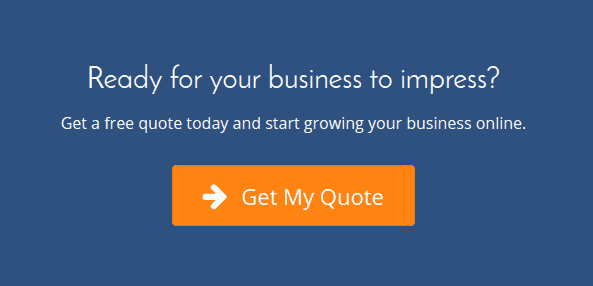Your small business online presence depends on converting visitors into customers. That means it’s important to try an increase website conversion rates however you can.
Breaking down the goal of a small business website down even further, every page should have a purpose and help convert visitors.
There is a difference between a landing page and a web page from a singular and a group purpose. Your website is a group of landing pages that are linked together. A landing page is a single page separate from your website.
Each page of your website should have a goal. People will rarely land on the front page of your website which means they won’t see a hierarchy. They’re often just looking for one thing.
They may land on a blog post looking for an answer or an information page looking for a service. Wherever they land, make sure you take advantage of that view and give visitors the opportunity to convert into a paying customer.
I’m going to cover the absolute necessities of optimizing each page and post for search engine and visitor optimization. I’m also going to cover why it’s important to make every page convert.
If you follow these tips then it will help you increase website conversion rates for your small business.
What Happens
When you optimize every page of your website it’s going to help convert visitors better. Your small business website is there for a reason, to convert visitors into customers, that means if you’re not getting conversions then you’re wasting money.
When a visitor to your website is given a clear path to reach their goal, they’re more likely to convert. A conversion for your business means something different than for others but with some planning and a goal, you’ll know exactly what you want visitors to do.
Here’s a scenario for a company which provides search engine marketing (SEM) and we’ll pretend that’s your business.
Scenario
Josef lands on your services page because he was searching Google for a company to help him with advertising on Facebook.
He’s looking at everything your business can help him do to achieve results on Facebook. After learning about your company, he likes the testimonials and what you offer. Josef is ready to discuss his needs with someone.
Josef doesn’t remember seeing any way to contact you or any action to take on your website. He’s a bit short on time so he can’t hunt too long so decided to revisit your website later.
This scenario isn’t uncommon. If Josef wasn’t successful the first time on your website, he’ll probably be lost forever.
If you designed your services pages to convert Joseph into a client, he would have found an obvious step forward on your website. That means Josef would have either become a client or at least would be in your funnel to eventually convert into a client.
Optimizing your website for search and visitor conversion will likely increase conversion rates on your entire website. Everything starts with on-page optimization because visitors to your website are often coming from a search engine or social media.
On-Page Optimization
When you want to increase website conversion rates, there are two types of pages you’ll be paying attention to. You’ll need to optimize blog posts and web pages to help visitors convert.
Your conversion opportunities begin off your website. You do have some control over what visitors see before they get to your website, though. Search engines pull certain information from your website to create their results which means this is your first conversion opportunity.
We’ll start with optimizing your blog posts from the beginning to the end of a visitors journey.
Optimize Your Blog Posts
There are four important parts to optimizing blog posts for your visitors journey. The four parts to optimize are the title, description, post content, and making sure your visitors journey completes.
There are other parts to search engine optimization but they have minimal affect on your website overall, though.
Let’s begin with the title.
Title
Your blog post title is essential to optimizing your content for search engines. It needs to be descriptive and help people decide what your post is about and how it will help them. Something attention catching is good but it still needs to stay on topic for the overall content.
Search engines pull the title of your blog post to be the title of your search result. That means your blog post title is going to be competing with other titles. Since your blog post title is competing for attention, it needs to set the stage for what visitors will find in the blog post.
Next up is the meta description which sometimes shows up in search results.
Meta Description
Your blog post meta description is important because it explains to potential visitors what they can expect to get out of your blog post. It’s essentially a brief sales pitch selling visitors on how your blog post will help them.
I mentioned above that search engines sometimes show your meta description. The reason they don’t always show it is because search results are dynamic. Your blog post may rank for a different keywords than you intended. That means your meta description might not include the keywords someone was searching for.
If the keywords a searcher uses aren’t included in your given meta description, search engines will create their own description. This will be a unique description just for those search results based off the part of your blog post that best fits the search.
Assume that you have control over the description that search engines choose even though it might not always be true.
Post Content
This is the most important part of your blog posts. The content your visitors came to see is right there in the post content. By optimizing your content for scanability, you’ll make sure your visitors can find what they’re looking for quick. Don’t make them read your whole post, you’ll lose them as a viewer that way and they’re unlikely to see your call-to-action.
Make sure your content includes links to other blog posts of yours or even references to other blog posts that aren’t yours.
Your post content will help complete a visitors journey. You also want to get something out of their visit, though. Make sure you complete your visitors journey on every blog post you write.
Completing The Journey
You want your visitors to have a good visit to your website. You also want to get something out of their visit. Most visitors will come to your website, find what they need, and leave.
There are those who love what they find, though, and you want to make sure you have the means to capture them as a potential lead.
Every blog post you make needs a call-to-action located somewhere in the post. A call-to-action could be an inline link in the post, a form at the end of the post, or even a pop-up.
The best call-t0-actions are seamlessly integrated into each blog post. It’s best to relate the call-to-action to the content you’re writing about. Your call-to-action should help visitors complete their journey seeking answers to their question.
Almost every post I write ends with a way visitors can take what I’ve written and get more with a custom report that specifically helps them improve their small business online.
Optimizing blog posts is important but pages on your website need to be optimized too.
Optimize Your Pages
It’s important to optimize every web pages on your website the same way you do blog posts. It’s wrongly interpreted that a website is for information only.
Visitors don’t visit your about page only to learn about you. Visitors want to learn about you AND if they like what they find then they want an action they can take.
Optimizing every page of your website ensures visitors find what they need and have an obvious next action to take. That doesn’t mean you throw a link or call-to-action at the top and bottom of every page, though.
Sometimes it’s necessary to put a call-to-action midway on a page if there’s a point where a decision might be made.
Having the next step for a visitor to take close at hand ensures you’re not letting their attention drift.
Every page of our website has multiple call-to-actions where it makes sense. Call-to-actions similar to the one

Each one of these call-to-actions is strategically placed at decision points. After information is provided about a solution a call-to-action provides a way for visitors to complete their journey on that page.
I covered some more complex methods of using a call-to-action, such as embedding it into blog posts. There are simpler methods, though, that can be just as helpful as a general call-to-action.
Call-To-Action
There are many ways you can provide a call-to-action on your pages. I mentioned some above, but there are more direct and simple versions that can be included even in your navigation. Some of the most common you may use are:
- Contact Us
- Chat Now
- Email Us
- Get A Quote
- Get A Consultation
- Shop Now
- Book An Appointment
- Learn More
The list could go on forever. This gives you the gist of it so you can create your own call-to-action that fits your page. The idea is to give a solid direction on what to do next.
You can even do things like exchange the word your or a/an with my to make it more personal. When someone is reading your call-to-action, seeing my makes it a bit more personal. It essentially makes them feel like it’s already theirs by putting them in the position of power.
Take Your Business Further
Are you ready to turn your website into a conversion powerhouse? I hope your answer is yes because that’s what your website should be doing.
If you’re ready to talk to a web design company that designs with



